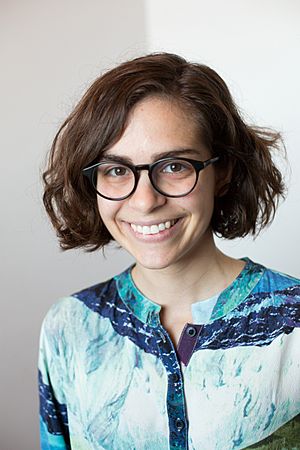Christina Agapakis facts for kids
Quick facts for kids
Christina Agapakis
|
|
|---|---|

Christina Agapakis in 2013
|
|
| Born |
Christina Maria Agapakis
|
| Alma mater | Yale University (BS) Harvard University (PhD) |
| Awards | Forbes 30 Under 30 (2012) |
| Scientific career | |
| Fields | Synthetic biology Bioengineering |
| Institutions | University of California, Los Angeles Ginkgo Bioworks |
| Thesis | Biological Design Principles for Synthetic Biology (2011) |
| Doctoral advisor | Pamela Silver |
Christina Maria Agapakis is a super cool scientist who works in a field called synthetic biology. This means she helps design and build new things using parts of living organisms. She's also a science writer, sharing amazing discoveries with everyone. She used to be the Creative Director at a company called Ginkgo Bioworks, where they engineer tiny living things like yeast and bacteria.
Contents
Becoming a Scientist
Christina Agapakis studied at two famous universities. She earned her first degree, a Bachelor of Science, in 2006 from Yale University. There, she focused on how tiny parts of living things, like cells and genes, work.
After Yale, she went to Harvard University to get her PhD. A PhD is a very high degree that shows you are an expert in your field. At Harvard, she worked with her mentor, Pamela Silver. Christina's research was about finding ways to design new biological systems. She thought about how genes and living pathways could be changed or created.
Amazing Science Projects
Christina Agapakis has worked on many interesting projects. She tried to make bacteria that could do photosynthesis (like plants) live inside animal cells. This would be like giving animal cells tiny power factories called chloroplasts. She also worked on making bacteria produce hydrogen fuel, which is a clean energy source.
Engineering Smells and Art
One of Christina's most famous projects was called "Selfmade." This project mixed science with art. She explored the tiny living things, called microbes, found in cheese and on the human body. Working with artist Sissel Tolaas, she collected bacteria from different parts of people's bodies. These samples were then used to create 11 types of "human cheeses." This was not meant to be food, but a way to make people think about microbes and our bodies. The project was shown at the "Grow Your Own" exhibition in Dublin.
After her PhD, Christina worked as a researcher at the University of California, Los Angeles (UCLA) from 2012 to 2014. She also spent time at UCLA's Art|Sci Center, where science and art meet.
Creative Director at Ginkgo Bioworks
Christina Agapakis became the Creative Director at Ginkgo Bioworks. This company is known as "The Organism Company." They use genetic engineering to change organisms like yeast and bacteria. They do this for many reasons, such as making perfumes, food, or even helping with farming.
For example, Ginkgo Bioworks engineered yeast to smell like roses. They changed the yeast's genes to make the same molecules that a rose produces for its scent. This rose oil fragrance was then used by a perfume company. Christina also led a project to create a library of bio-based scents. One goal was to bring back the smell of a flower that no longer exists. Scientists analyzed old plant samples to find the DNA that made the flower smell. Then, they engineered yeast to make those same smells.
In her role, Christina helps people understand what bioengineering is all about. She wants to make biotechnology seem less complicated and more exciting. For instance, Ginkgo hosted a designer who experimented with using bacteria to dye fabrics. This could be a more eco-friendly way to color clothes.
Sharing Science Stories
Christina Agapakis is also a talented science writer. She started writing a blog when she was in graduate school. In 2011, she began writing a column for Scientific American called "Oscillator." In her column, she shared her ideas on new discoveries in synthetic biology with a wide audience. She wrote about topics like being kind to the environment and how art and science can work together.
She has also written for other popular science magazines. She highlighted the amazing women who helped create the field of microbiology for Popular Science. Christina also helped start a science magazine called Method Quarterly. This magazine explored how science really works.
Awards and Recognitions
Christina Agapakis has received many awards for her work:
- Forbes 30 Under 30, 2012 (This award recognizes 30 bright young people under 30 years old.)
- L'Oreal USA Fellowship for Women in Science, 2012
- UdK Award for Interdisciplinary Art and Science, 2012
- 100 Most Creative People in Business, Fast Company, 2016
- Next List 2017: 20 People Who Are Creating the Future, Wired, 2017
- Excellence in Public Engagement Award, SynBioBeta, 2018
See also
 In Spanish: Christina Agapakis para niños
In Spanish: Christina Agapakis para niños

